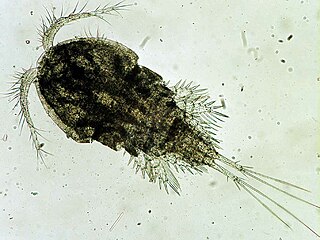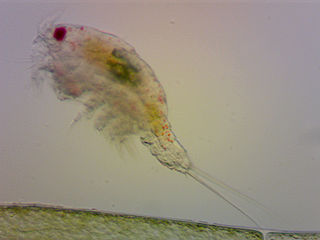Related Research Articles
Tantulocarida is a highly specialised group of parasitic crustaceans that consists of about 33 species, treated as a subclass of the class Hexanauplia. They are typically ectoparasites that infest copepods, isopods, tanaids, amphipods and ostracods.

The family Argulidae contains the carp lice or fish lice – a group of parasitic crustaceans of uncertain position within the Maxillopoda. Although they are thought to be primitive forms, they have no fossil record. The Argulidae are the only family in the order Arguloida, although a second family, the Dipteropeltidae, has been proposed.

The Cyclopoida are an order of small crustaceans from the subclass Copepoda. Like many other copepods, members of Cyclopoida are small, planktonic animals living both in the sea and in freshwater habitats. They are capable of rapid movement. Their larval development is metamorphic, and the embryos are carried in paired or single sacs attached to first abdominal somite.

Calanus is a genus of marine copepod in the family Calanidae. The genus was split in 1974, with some species being placed in a new genus, Neocalanus. The following species are recognised:

Poecilostomatoida are an suborder of copepods. Although it was previously considered a separate order, recent research showed it to be nested within the Cyclopoida
Arctodiaptomus kamtschaticus is a species of crustacean in the family Diaptomidae. It is endemic to lakes in Kamchatka, eastern Russia, and is listed as a vulnerable species on the IUCN Red List.

Attheyella is a genus of copepods in the family Canthocamptidae, containing the following species:
Boeckella is a genus of copepods in the family Centropagidae.
Calamoecia is a genus of copepods in the family Centropagidae confined to Australasia. It is thought to have evolved since the separation of the Australian continent from Antarctica. Three of the Australian endemic species are listed as vulnerable species on the IUCN Red List. The genus contains the following species:
Dussartius baeticus is a species of crustacean in the family Diaptomidae. It is endemic to the Iberian Peninsula, having been found in south-eastern Spain, and in the waters of the Tagus estuary, the Caniçada reservoir, and four reservoirs in the Mondego system in Portugal.
Fibulacamptus is an Australian endemic genus of crustacean in the family Canthocamptidae. Two of the four species are listed as vulnerable species on the IUCN Red List :
Hemiboeckella is a genus of crustacean in family Centropagidae. It contains the following species:
Hesperodiaptomus is a genus of copepods in the family Diaptomidae, containing 18 species. Two species – H. augustaensis and H. californiensis – are endemic to the United States and listed as vulnerable species on the IUCN Red List.
Mastigodiaptomus is a genus of Neotropical copepods in the family Diaptomidae. Two of the eight species in the genus are listed as Data Deficient (DD) on the IUCN Red List, and one is listed as a vulnerable species (VU):
Murunducaris juneae is a species of crustacean in the family Parastenocarididae. It is endemic to Brazil.
Muscocyclops is a genus of copepod crustaceans in the family Cyclopidae, comprising three species found only in South America. Two of the species – Muscocyclops bidentatus Reid, 1987 and Muscocyclops therasiae Reid, 1987 – are endemic to the Distrito Federal in Brazil, and are listed as conservation dependent on the IUCN Red List. The third species is Muscocyclops operculatus.
Phyllodiaptomus is a genus of crustacean in the family Diaptomidae. It includes the following species:
Ponticyclops is a genus of copepods in the family Cyclopidae.

Tegastidae is a family of copepods, which are characterised by having laterally compressed bodies, a claw-like mandible in the nauplius stage, and by a modified male genital complex. 85 species have been described in 6 genera. Two species of Smacigastes are found at hydrothermal vents, while the remaining species are found in shallow water, associated with algae, bryozoans and cnidarians, such as corals.
Parastenocarididae is a family of copepods in the order Harpacticoida adapted to life in groundwater. It contains the following genera:
References
- ↑ T. Chad Walter (July 15, 2008). T. Chad Walter; Geoff Boxshall (eds.). "Murunducaris Reid, 1994". World Copepoda database. World Register of Marine Species . Retrieved December 31, 2009.